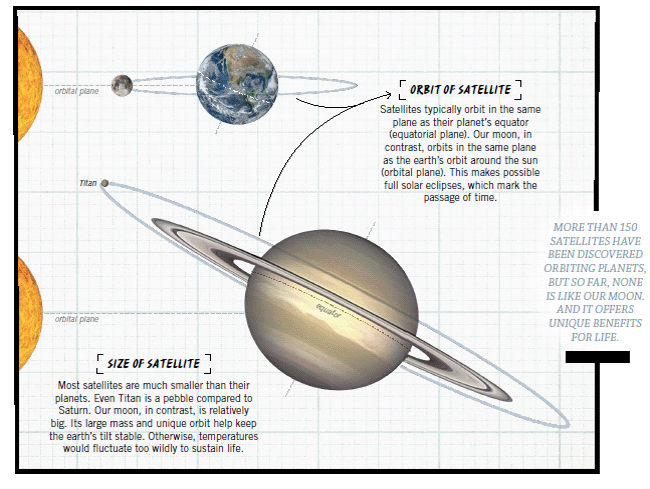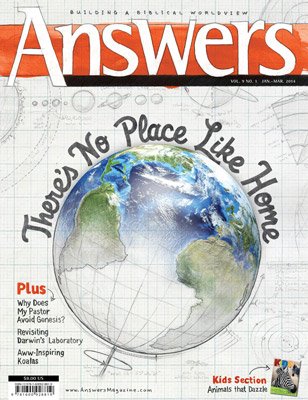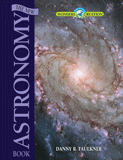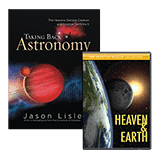A Perfect Partner
Special Feature: There’s No Place Like Home
You’ve probably never heard this example in discussions about the basic requirements of extra terrestrial life. But our moon isn’t just a pretty dot in the night sky—it helps make life possible. And as far as we know, no other planet in the universe has anything like it.
The more we learn about our solar system, the more we recognize our moon’s uniqueness. The moon is the earth’s only natural satellite. Mercury and Venus have no satellites, and Mars has only two very small moons. The gas giant planets—Jupiter, Saturn, Uranus, and Neptune—have many satellites, in excess of 150, and more likely will be found. However, most of the satellites (and all the recently discovered ones) are very small compared to our moon.
Why did God make a unique moon? Since the first night Adam stared up at the starry heavens, he must have marveled how the “lesser light” illuminated his otherwise dark nights. In recent times, astronomers have discovered other benefits of the moon, which helps to regulate living conditions on the earth. As far as we know, no other planet in the universe has such a perfectly matched satellite.
When compared with the mass1 of the earth, the moon is very large. While some of the satellites of Jupiter and Saturn are more massive than our moon, those satellites aren’t very large when compared to the size of their respective planets. Unlike most satellites in the solar system, which orbit above the equators of their respective planets, the moon orbits in the same plane as the earth orbits the sun (see image).

photos: NASA
At the very least, this unusual orbit suggests that the moon’s origin is unique, as we’d expect from the creation account because the moon was specially designed to provide light for us and to rule the night (Genesis 1:14–18).
Regulating the Earth’s Tilt
The moon’s relatively large size and unusual orbit are important for several reasons. While the sun’s gravity is the dominant force in the solar system, all the other objects in the solar system tug on one another. We call these small gravitational tugs perturbations. These perturbations, if left to themselves, would cause the earth’s axial tilt to change dramatically over the years, varying from 0° to 90°. As the tilt gradually changed, both the tropic and the Arctic regions would expand and contract. When the tilt exceeded 45°, some locations would be in both zones at the same time!
This hasn’t happened, but it would be very bad for living things if it did. Instead, by God’s wise design, the moon’s relatively large mass and unusual orbit combine to stabilize the earth’s tilt. As a result, the tilt varies no more than about two degrees.
Regulating Tides
The size and orbit of the moon are also ideal for producing tides on the earth. The daily fluctuation of the tides helps cleanse the shores of the ocean, and they play a vital role in the lives of many sea creatures.
Other Blessings
The moon’s many other benefits may not seem life-saving, but they are just as important to human life. It is no accident that the sun is 400 times larger than the moon, while the sun is 400 times farther away. This unique situation means that the sun and moon appear about the same size in the sky. So during a total solar eclipse the moon just barely covers the sun. As a result, total solar eclipses are both rare and spectacular. Since the earliest times, nations have used these special events to record the passage of time.
Besides this, total solar eclipses allow astronomers to study certain features of God’s creation, such as the corona (the “crown” of charged particles surrounding the sun), which they can’t observe at any other time. Besides being very beautiful, the corona is not well understood, so additional study of it is very important in improving our knowledge of the sun.
Indeed, the moon’s existence made modern science possible. One of the key moments in the development of science, as we know it, was Sir Isaac Newton’s work with gravity. The greatest problem that Newton tackled was the reason the moon orbited the earth each month. In solving that problem, Newton developed his theory of gravity. If the earth didn’t have the moon, Newton might never have reached his amazing insight into the fundamental laws of God’s creation.
While we are thankful that the moon sustains physical life and increases our scientific knowledge, life involves more than the body and mind. The moon provides beauty and wonder. Like every other detail in God’s creation, the moon’s design points to the power and wonder of the Creator of all things, Jesus Christ, for all to see (Romans 1:20).
Special Feature: There’s No Place Like Home
- Just Right for Life
- Not Just Another Star
- A Perfect Partner
- A Unique Blend
Answers Magazine
January – March 2014
Placed safely in our solar system’s “goldilocks zone” and engineered with the perfect balance of atmosphere, chemicals, and water, our earth was miraculously formed to be inhabited (Isaiah 45:18). This issue examines the earth’s unique suitability for life. We’ll also investigate what seminaries are actually teaching our pastors, the possibility that viruses could be beneficial, and more.
Browse IssueFootnotes
- Mass is the measure of how much matter an object contains.
Recommended Resources

Answers in Genesis is an apologetics ministry, dedicated to helping Christians defend their faith and proclaim the good news of Jesus Christ.
- Customer Service 800.778.3390
- Available Monday–Friday | 9 AM–5 PM ET
- © 2025 Answers in Genesis





